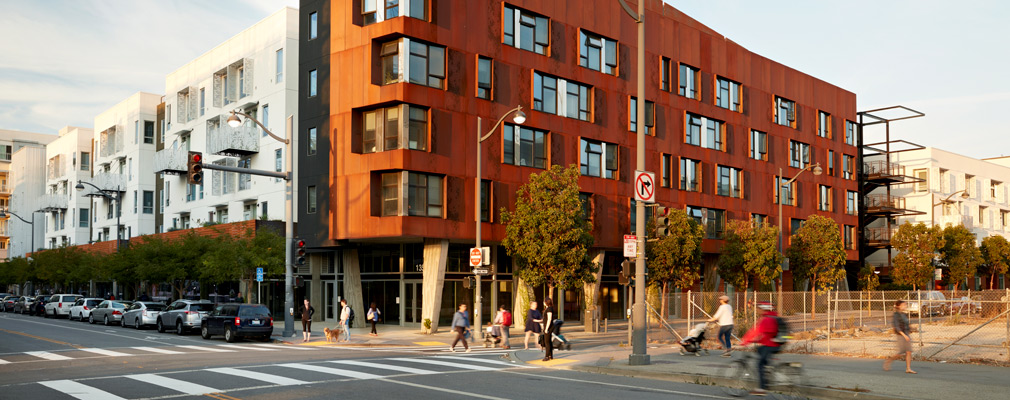
San Francisco: proposed Affordable Housing. (Photo: HUD.gov)
California Government is the Reason for California’s Housing Shortage
In some jurisdictions, developers pay as much as $157,000 in fees on each single family home constructed
By Katy Grimes, March 5, 2020 9:15 am
The homebuilder Lennar has new affordable homes for sale in San Antonio, Texas with nine different floor plans to choose from at a variety of price points – starting in the $130,000s.
In California, permits and development fees often total more than $130,000 before ground is even broken. A report published by UC Berkeley found that development fees can compromise up to 18% of the cost of a new home. In many jurisdictions, developers pay as much as $157,000 in fees on each single family home constructed, ahead of actual construction.
“Ranging in size from 466 to 1,950 square feet of living space, the homes at Republic Meadows offer one to four bedrooms and one to two-and-a-half baths,” Builderonline.com reported about the Lennar homes in San Antonio.
Compare the San Antonio housing to Sacramento’s Lennar homes: the “high $400,000s” in South Sacramento, the “mid $400,000s in Natomas, and the “low $400,000s” in Rancho Cordova. These neighborhoods are standard track housing, middle-working class areas, and these are just the starting prices before any upgrades.
In California, housing “solutions” were offered by Apple, which promised $2.5 billion in affordable housing; Facebook pledged $1 billion in affordable housing funds; and Sen. Scott Wiener (D-San Francisco) pushed his high-density housing bill, SB 50. Democrats have tried rent control, and mandating cities build a certain percentage of “affordable housing,” to no avail.
A flurry of eight related Assembly housing bills proposing to target development and impact fees claims to be a solution, but are word salads lacking any real solutions:
AB 1484: Provides a comprehensive reform of the nexus standards that cities and counties use to determine their fees.
AB 1924: Requires jurisdictions to assess fees on a per-square-foot basis, giving developers the option to build smaller, more affordable units without being penalized with multiple fees.
AB 3144: Provides state funding to reimburse local governments who waive impact fees on affordable projects.
AB 3145: Establishes a ceiling for development fees based on the median home price in a jurisdiction. Cities and counties that exceed this ceiling will be required to seek approval from the Department of Housing and Community Development, and justify the need to do so.
AB 3146: Requires cities and counties to report a wide variety of essential housing data to the Department of Housing and Community Development, including the number of new housing units that have been issued a completed entitlement, a building permit, or a certificate of occupancy.
AB 3147: Ensures that certain impact fees are payable under protest. This allows for a developer to pay a fee they consider to be unreasonably high so they can continue construction.
AB 3148: Reduces the impact fees paid on affordable housing units that are built using the state’s density bonus program.
AB 3149: Modernizes the way that local agencies notify interested parties prior to levying a new fee or service charge or prior to approving an increase in an existing fee or service charge.
The Berkeley study addresses this:
“Our conversations with experts and stakeholders made it clear that some approaches would not be productive. Simply capping impact fees statewide, for example, could cut off much-needed revenue, resulting in lowered levels of public services and potentially incentivizing cash-strapped localities to block new housing altogether.”
“Over the course of 2017 alone, the national single-family and multifamily construction price indexes increased by 5.6 percent and 6.3 percent, respectively, compared to an average annual increase of 2.7 percent between 1990 and 2000. In that year, New York, San Francisco, San Jose/Silicon Valley, and Oakland ranked among the most expensive construction markets.”
“The cost of building a 100-unit affordable project in California increased from $265,000 per unit in 2000 to almost $425,000 in 2016. The same trends that increase costs for market-rate housing (such as land pricing, construction costs, and regulation) impact affordable housing. In addition, affordable projects are often subject to increased local scrutiny, further inflating costs. A 2014 study found that local government design requirements for affordable housing added an average of seven percent in total costs, and that community opposition (measured by holding four or more community meetings) increased expenses by five percent.”
While Gov. Gavin Newsom punishes cities he claims are not complying with the state’s affordable housing mandates, the California Legislature and governors have allowed more and more state mandates on all construction, including affordable housing: rooftop solar mandates and requirements that all new homes be “net-zero,” green homebuilding standards, fire sprinkler mandates, CEQA requirements, environmental impact studies, and many, many more.
Newsom even sued the Orange County city of Huntington Beach for failing to provide enough additional “affordable housing,” while his own home county of Marin has enjoyed a moratorium on affordable housing building requirements and will do so until 2028.
While former Gov. Jerry Brown signed the 2017 budget bill allowing Marin County to remain exempted from affordable housing requirements, he also signed SB 1333 in 2018 to eliminate a “housing loophole” that allows charter cities to reduce sites zoned for affordable housing, even if the action is inconsistent with the cities’ adopted general plans, which is a violation of the California Constitution.
Republicans argued against the housing exemption in the trailer bill, and asked why Marin was allowed to ignore its own housing needs, and instead export its housing obligations to neighboring counties.
“But Democrats who posture as fierce advocates for more housing, even those carrying high-profile housing bills, such as Sens. Toni Atkins and Jim Beall, voted for it and Gov. Jerry Brown signed it,” Dan Walters reported. “For at least another decade, therefore, Marin’s residents can smugly assume that their bucolic lifestyles will not be marred by having more neighbors who don’t make as much money and, you know, just don’t fit in.”
Nearly every attempt to reform the California Environmental Quality Act has been met with a wall of resistance. Instead, lawmakers simply vote to exempt powerful and wealthy development projects from CEQA: Sacramento’s Golden1 Center for the Kings basketball team; San Francisco’s Warriors arena; and the Inglewood Chargers/Rams Hollywood Park stadium, to name just a few.
Meanwhile, infrastructure projects, affordable housing, and even transportation projects come under extreme “environmental” scrutiny.
This housing shortage in California was created by California government and politicians, through and through. These pretend “fixes” only add to the burden.
- Requiescat in Pace Congressman Doug LaMalfa - January 6, 2026
- California DEI Education Continues Despite Presidential Executive Order to End It - January 6, 2026
- Whoa! The SMUD CEO’s Salary is Over $900,000 Annually - January 6, 2026





Excellent analysis, Katy, and very well researched. Thank you for this critical information.
Couldn’t agree more — OUTSTANDING article on this subject. Hardly need to add how completely GALLING it is to watch the governor wag his finger and back into a corner cities like Huntington Beach (for childish revenge) when he and his fellow Democrats are completely and thoroughly responsible for causing this impossible housing problem in the first place. And now to see EIGHT assembly bills that pretend to address the situation but are the usual incomprehensible gibberish. (Why not just combine them all and propose ONE bill of incomprehensible gibberish?) If these Democrats would TAKE responsibility, as they should, we would begin to see some needed changes, but I’m not God, I don’t have a magic wand, and I’m exhausted from holding my breath.
An “outstanding article”? “Well-researched”? Sorry, I’m not seeing it. Ms. Grimes makes the argument in the second paragraph that high developer’s fees contribute dramatically to the high cost of housing construction in California and then summarize 8 bills that aim to lower those fees. Lowering developer’s fees is supposed to be a bad thing? It is unclear whether you believe that lowering developer’s fees is good or bad. You pick a few phrases out of a UC Berkeley report that is supposed to do what? Are those statements meant to support the argument that lowering fees is not good, or is insufficient to adequately lower housing costs? One of the quotes from the Berkeley study mentions that lowering developer fees will leave cities and counties without an important source of funding. What you irresponsibly fail to mention in this article is that legislators are well aware of this fact and have acknowledged that an alternative source of funding will need to be provided to provide municipalities with the money necessary to provide public services.
I think it was rather well-known before this particular article that state mandates for solar and all-electric systems and the costs that result and other fees for permits and open space and so-called “affordable housing” and just about anything one can think of have added hundreds of thousands of dollars to the cost of just ONE new home. Add property taxes and increasing energy and water costs and a home becomes un-affordable for most of the population right out of the gate.
Do you want more housing built or not? If you do, you’re going to have to support clearing some of the government obstacles from the process, even if what you want is that dreadful stack-and-pack stuff that is also made un-affordable-for-most by these mandates and fees. Never mind that the over-crowded urban space is not at all attractive at the moment to people who are currently freaking out big time about close proximity to other humans in this era of the corona virus and other disease threats in the cities.
As someone who actually works for a city in California I can tell you that the biggest expense for developers are the state mandated EIR, mitigation and other regulatory fees and all the other expenses that come with having to deal with our heavy handed regulation in this state. Cities already get ongoing funding to support infrastructure for developments from CFDs (aka Mello Roos) that are tacked on to the property tax bills. Also, the immense amount of legal fees that developers must put forth to fight CEQA litigation is also limiting developer desire to build in this state. The issues aren’t so much the permitting fees (which are excessive in some cases) but the over-burdensome regulations that drive up costs for the developers and make them go to other states to do business instead.
California. Ain’t never gonna learn…
Thanks for this information. The environmental stuff, of course! The list is so long, and growing by the day, it seems…
California has become a state of the super rich and the desperately poor! No one in between. There aren’t enough CITIZENS in the state to pay the taxes to support all these stupid regulations! What about the guy who needs a $200,000 dollar house, or less? He’s not even mentioned in the article. Low $400,000 is not attainable for a lot of working people!
Thank you Jen for passing on such an important article. Yes, the housing situation has gotten so ridiculous here in California and local small government is not to blame. There are so many state mandated laws that it makes it difficult for small cities to provide adequate housing. The state pushes on small cities high RENA numbers forcing them to comply with low income (affordable housing) and eliminating or decreasing med to high income homes. (through strict building demands eg; mandated solar etc.) This changes the dynamics of a town discouraging others from moving to those areas. Even in areas where medium to high income level housing has been built, the state and cities approve low income housing adjacent to them decreasing the value of their homes. The state needs to look at all erroneous housing issues and make it fair for all. We look a lot at why California’s housing is so bad for our homeless but we need to look at why it is also difficult for other income levels as well. Until they do that it won’t change the overall problem in California, and people who are in the middle to higher income earning levels will continue to leave California. I am a native Californian, and I never thought that our state would get so bad that people would be leaving in droves. But they are. Wake up legislature and get rid of all the red tape that you have slapped on to housing. Until you do, we will continue to decline.
I believe there was a typo concerning the the range of home sizes built by Lennar. It should be 1466 not 466 sf. Otherwise a great article. The regulations were a major reason for me to move to Florida.
The article in Builder.com said there were nine sizes of homes, “Ranging in size from 466 to 1,950 square feet of living space, the homes at Republic Meadows offer one to four bedrooms and one to two-and-a-half baths. Prices start from the $130,000s.”
Libs are the reason for allot of cr@p….. and that too..